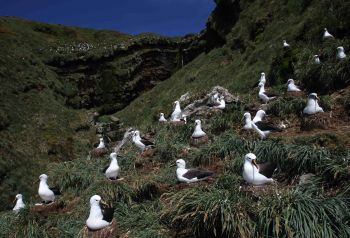Karine Delord (Centre d’Etudes Biologiques de Chizé, Centre National de la Recherche Scientifique, Villiers en Bois, France) and colleagues have published in the Journal of Field Ornithology on using a kite to take aerial photographs of seabird colonies. The senior author considers the technology could be used to take low-cost photographs of breeding albatrosses and surface-breeding petrels, including under windy conditions as prevail on sub-Antarctic islands.
The paper’s abstract follows:
“Obtaining aerial high-resolution images of bird nesting colonies using remote-sensing technology such as satellite-based remote sensing, manned aircraft, or Unmanned Aerial Vehicles might not be possible for many researchers due to financial constraints. Kite Aerial Photography (KAP) provides a possible low-cost alternative. We collected digital images of ground-nesting seabirds (i.e., cormorants and penguins) in two different ecosystems using a kite-based platform equipped with consumer-grade digital cameras with time-lapse capability to obtain estimates of breeding population size. KAP proved to be an efficient method for acquiring high-resolution aerial images. We obtained images of colonies of seabirds ranging in size from hundreds to several hundreds of thousands breeding pairs during flights lasting from a few minutes up to three hours, from flat to very steep areas, and in contrasted wind conditions (from 0.5 to 6 Beaufort force). KAP is an efficient low-cost method for acquiring high-resolution aerial images and an alternative to ground-based censuses, especially useful in rugged areas.”

Indian Yellow-nosed Albatrosses breeding on Prince Edward Island: suitable for kite aerial photography?
Photograph by Peter Ryan
With thanks to Karine Delord.
Reference:
Delord, K., Roudaut, G., Guinet, C., Barbraud, C., Bertrand, S. & Weimerskirch, H. 2015. Kite aerial photography: a low-cost method for monitoring seabird colonies. Journal of Field Ornithology 86: 173-179.
John Cooper, ACAP Information Officer, 04 June 2015

 English
English  Français
Français  Español
Español